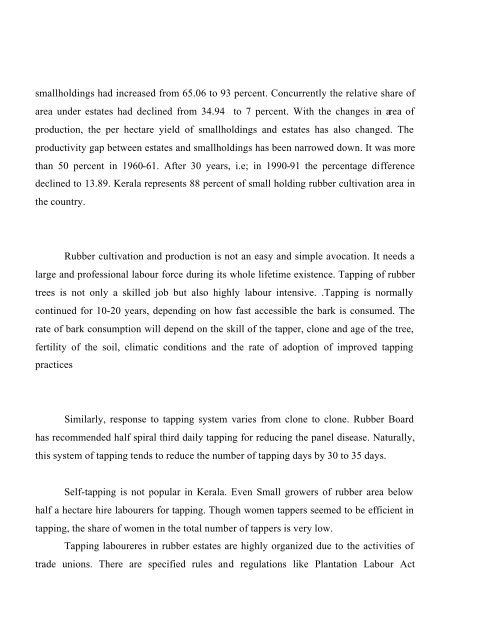socio-economic profile of rubber tappers in the small holding sector
socio-economic profile of rubber tappers in the small holding sector
socio-economic profile of rubber tappers in the small holding sector
Create successful ePaper yourself
Turn your PDF publications into a flip-book with our unique Google optimized e-Paper software.
<strong>small</strong>hold<strong>in</strong>gs had <strong>in</strong>creased from 65.06 to 93 percent. Concurrently <strong>the</strong> relative share <strong>of</strong><br />
area under estates had decl<strong>in</strong>ed from 34.94 to 7 percent. With <strong>the</strong> changes <strong>in</strong> area <strong>of</strong><br />
production, <strong>the</strong> per hectare yield <strong>of</strong> <strong>small</strong>hold<strong>in</strong>gs and estates has also changed. The<br />
productivity gap between estates and <strong>small</strong>hold<strong>in</strong>gs has been narrowed down. It was more<br />
than 50 percent <strong>in</strong> 1960-61. After 30 years, i.e; <strong>in</strong> 1990-91 <strong>the</strong> percentage difference<br />
decl<strong>in</strong>ed to 13.89. Kerala represents 88 percent <strong>of</strong> <strong>small</strong> hold<strong>in</strong>g <strong>rubber</strong> cultivation area <strong>in</strong><br />
<strong>the</strong> country.<br />
Rubber cultivation and production is not an easy and simple avocation. It needs a<br />
large and pr<strong>of</strong>essional labour force dur<strong>in</strong>g its whole lifetime existence. Tapp<strong>in</strong>g <strong>of</strong> <strong>rubber</strong><br />
trees is not only a skilled job but also highly labour <strong>in</strong>tensive. .Tapp<strong>in</strong>g is normally<br />
cont<strong>in</strong>ued for 10-20 years, depend<strong>in</strong>g on how fast accessible <strong>the</strong> bark is consumed. The<br />
rate <strong>of</strong> bark consumption will depend on <strong>the</strong> skill <strong>of</strong> <strong>the</strong> tapper, clone and age <strong>of</strong> <strong>the</strong> tree,<br />
fertility <strong>of</strong> <strong>the</strong> soil, climatic conditions and <strong>the</strong> rate <strong>of</strong> adoption <strong>of</strong> improved tapp<strong>in</strong>g<br />
practices<br />
Similarly, response to tapp<strong>in</strong>g system varies from clone to clone. Rubber Board<br />
has recommended half spiral third daily tapp<strong>in</strong>g for reduc<strong>in</strong>g <strong>the</strong> panel disease. Naturally,<br />
this system <strong>of</strong> tapp<strong>in</strong>g tends to reduce <strong>the</strong> number <strong>of</strong> tapp<strong>in</strong>g days by 30 to 35 days.<br />
Self-tapp<strong>in</strong>g is not popular <strong>in</strong> Kerala. Even Small growers <strong>of</strong> <strong>rubber</strong> area below<br />
half a hectare hire labourers for tapp<strong>in</strong>g. Though women <strong>tappers</strong> seemed to be efficient <strong>in</strong><br />
tapp<strong>in</strong>g, <strong>the</strong> share <strong>of</strong> women <strong>in</strong> <strong>the</strong> total number <strong>of</strong> <strong>tappers</strong> is very low.<br />
Tapp<strong>in</strong>g laboureres <strong>in</strong> <strong>rubber</strong> estates are highly organized due to <strong>the</strong> activities <strong>of</strong><br />
trade unions. There are specified rules and regulations like Plantation Labour Act










